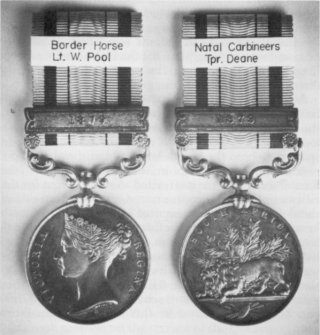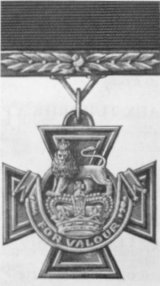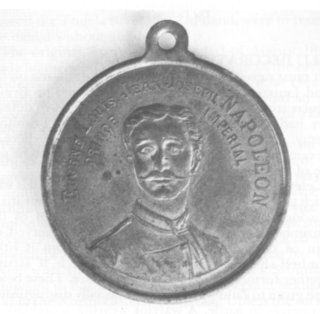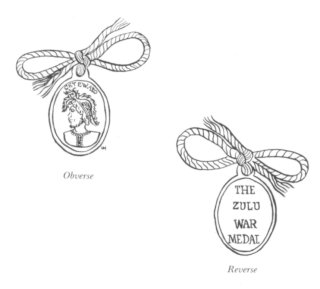

 The South African
The South African
No campaign medal was instituted exclusively for the Zulu War. Bloody and hard-fought as it was, the War was no doubt regarded in Britain as but a part of the general fighting that took place from 1877 to 1879 between the various African tribes in Southern Africa and their British and Colonial overlords.
In 1854 royal sanction had been given for the award of a medal to the survivors of British regular troops who had served in any one of the three campaigns of 1835-36, 1846-47, or 1850-53, on the Eastern Frontier of the Cape Province. Designed by William and L.C. Wyon, this medal bears on the obverse a beautiful portrayal of Victoria as the young queen, wearing a coronet. The reverse shows a lion, half-crouching watchfully, behind a protea bush, with the date '1853' in the exergue.
In 1880 it was ordained that the same medal should he awarded to all personnel - Colonial volunteers and native levies as well as British regulars - who had served in any of the campaigns in South Africa between September 1877 and December 1879, namely the Gaika / Galeka War, the Northern Border War, the lst and 2nd Sekukuni Wars, the Moirosi's Mountain campaign in Basutoland, and the Zulu War. A bar or clasp was to be attached to the suspender of the medal hearing the date or dates of the year or years in which the recipient had actually served in any of those campaigns. Military personnel who had been mobilized in Natal, but had not crossed the Tugela River into Zululand, were to receive the medal without any bar.
The original Army Order, no 103 of August 1880, made no mention of any change in design of the earlier model. However, the date '1853' was clearly inappropriate, and it was therefore replaced in the reverse exergue by a military trophy consisting of a Zulu ox-hide shield and four crossed assegais.
Participants in the Zulu War received this medal without a bar if they remained on the Natal side of the Tugela, or with the bar '1879' if they actually saw service in Zululand. One can say with confidence that a medal without a bar is a medal awarded for service in connection with the Zulu War, albeit not combatant service. Problems arise, however, when one is faced with a medal bearing the bar '1879', for the same bar was given with the medal for the Moirosi's Mountain campaign in Basutoland, and for the Second Sekukuni War in the North-Eastern Transvaal. Unless the service details of the recipient are known, the only way to establish whether the bar '1879' was indeed for the Zulu War is to look at the name of the unit (which will be found engraved, together with the recipient's rank and name, on the edge of the medal) and to check that the unit concerned was in Zululand.
Imperial troops who participated included two regiments of cavalry and fifteen infantry battalions (see Appendix I), together with a composite Naval Brigade, detachments of the Royal Artillery and Royal Engineers, and members of the various supporting commissariat, ordnance, and medical services. In addition there were a considerable number of 'odd men' - often officers - drawn from a wide variety of British regular and militia units who were sent out as members of the staff or as observers. Some enthusiastic adventure-seekers qualified for the medal by reaching the front line entirely on their own initiative, and even at their own expense!
The Natal colonists also played their part. Forces called out on full mobilization to meet the threat of Cetewayo's estimated 40 000 warriors included the Natal Mounted Police (a semi-military formation, and the only 'regulars) and all the Natal Volunteer units then in existence. The Frontier Light Horse and units such as Raaff's Transvaal Rangers and the Kaffrarian Rifles came from the other colonies. Special reserve units were established in Pietermaritzburg and Durban for local garrison duty and large numbers of Natal Natives were enlisted. (see Appendix II).

The Campaign Medal for the Zulu War -
the medal for "South Africa 1877-79", with bar "1879".
Left: Obverse of medal awarded to Lieut. W. Pool,
Border Horse, killed in action on Hlobane Mountain.
Right: Reverse of medal awarded to Trooper J. Deane,
Natal Carbineers, killed in action at Isandlwana.
The ultimate - if in practice unattainable - collection of medals of the Zulu War would include medals to all these formations. It would include not only all the 'odd-man' units on the Imperial side - to some of which only one medal was issued - but also the many small Natal units bearing such glamorous names as Carbutt's Border Rangers, Isipingo Mounted Rifles, and Weenen Yeomanry.
Alternatively, the collector can aim to represent in his collection a recipient from each of the major actions of the war. This theme involves considerable research, and final verification of participation in a particular action - unless the recipient was a casualty - can be tantalizingly difficult in the absence of personal letters or a diary. One can, however, consult the full casualty rolls for Isandlwana or Hlobane Mountain, and Chard's report on the defence of Rorke's Drift contains a comprehensive nominal roll of the defenders. Press reports, regimental histories, church or battlefield memorials - all these may provide useful information. It is interesting to record that whereas Colonial Forces Order no. 169 (issued at Kingwilliamstown on 14th September, 1880, to announce the granting of the medal) stated specifically that 'the Medal will be granted to survivors only ...', no such restrictive condition appeared in the original Imperial Army Order no.103 of 1st August, 1880. Whatever happened in the Cape of Good Hope, it is certain that medals were given to the next-of-kin of men killed in action in Zululand. Medals to Isandlwana casualties, in particular, are much sought after and command a substantial premium.
DECORATIONS FOR THE ZULU WAR
In 1879, apart from promotion in the field, or brevet rank for officers, the only available means of rewarding gallantry or distinguished service was by the award of either the Victoria Cross or the Distinguished Conduct Medal. Both of these decorations had been instituted at the end of the Crimean War. (The Distinguished Service Order was established only in 1886 and the Military Cross and Military Medal followed much later, during the 1st World War).
The Zulu War saw the award of twenty-three Victoria Crosses and 15 Distinguished Conduct Medals. The story of Lieutenants Coghill and Melvill who died fighting to the last at Fugitives Drift after their gallant attempt to save the colours when their Regiment, the 1st Battalion 24th Regiment (later The South Wales Borderers) was overrun at Isandlwana, and who were given the V.C. by King Edward VII in 1907, when posthumous awards were first authorized, is well known. It was at Fugitive's Drift, too, that Private Wassall of the 80th Regiment of Foot earned his Cross rescuing a comrade in the wild fury of the flooded Tugela under a hail of Zulu bullets.
The historic and emotion-stirring defence of Rorke's Drift on the evening of the Isandlwana disaster of the 22nd January was marked by the award of no less than 11 Victoria Crosses and 5 Distinguished Conduct Medals - an all-time record for a single action. The disasters at Hlobane Mountain and at the Intombi River likewise brought their quota of 'Valour beyond the call of duty', as did the epic victories of Kambula and Ulundi. As will be seen from the attached schedule, (Appendix III), of the major actions of the Zulu War only the gallant defence of Eshowe, and the battle on the Inyezane River, near Gingindlovu, on the 2nd April, failed to gain the distinction of a decoration. It is particularly interesting to note that two black African NCOs of the Natal Native Horse won the DCM - at Kambula and on the Umfolozi River before Ulundi respectively.

The Victoria Cross
ZULU DECORATIONS
It must never be forgotten that at Isandlwana on the
22nd January, 1879, Zulu warriors inflicted on British
regular troops one of the most comprehensive defeats
they had ever received at the hands of a 'primitive'
enemy. Again at Hlobane Mountain and elsewhere in
the campaign the Zulu fighting man showed that he was
one of the bravest of the brave.
Cetewayo had no bronze crosses or silver medals with
which to decorate his heroes. But he did have a means of
showing his special approbation. The wood of the
Umzimbete or uMyezane tree was specially reserved, on
pain of death, for the Zulu king. From it little
dumbell-shaped beads were cut, which if strung
together formed an interlocking necklace. These beads
were given to Zulu warriors who specially distinguished
themselves in battle. A warrior wearing a necklace of
these beads was regarded with no less respect than a
British holder of the VC.

The Zulu "VC" - wooden beads from the royal tree
worn as a necklace by recognised Zulu heroes.
EUGENE LOUIS JEAN JOSEPH NAPOLEON, THE PRINCE IMPERIAL OF FRANCE
One of the many young men who made their way out
to South Africa to share in the excitement and
adventure of the Zulu War was 23-year-old Louis
Napoleon, the Prince Imperial, the last hope of the
Royalists of France, who had been living in exile in
England. His death at the hands of a small Zulu impi
while on an allegedly 'safe' mission to select a camp site
on the route of advance to Ulundi, was to shake Europe.
His death is commemorated by a small medallion in
brassy bronze, 32 mm in diameter, which portrays on
the obverse his bare-headed bust in military uniform,
with his name in full. On the reverse, within a wreath is
the inscription in French:
So died the last of the Bonapartes!

Medallion in commemoration of
Louis Napoleon the Prince Imperial of France,
killed in Zululand on 1st June, 1879.
'CETEWAYO'S ZULU WAR MEDAL'
Following Cetewayo's capture at the end of August, 1879 he was taken to Cape Town where he was imprisoned, first in the Castle, and later under much less-rigorous conditions at Oude Molen, near present-day Pinelands. More than three years were to pass before his eventual return to Zululand.
A rare and interesting little medalet is believed to date from the time of his imprisonment. In fact local tradition in Cape Town has it that Cetewayo was in the habit of presenting his medal to the more important of his many visitors.
Poor Cetewayo was quite a tourist attraction at the time, and English ladies of gentle birth visiting Cape Town made sure they called on the savage black potentate!
This little oval medalet in cheap metal (?in tin plate) is 16 mm by 13 mm in size and has a perforated 'ear' at the top through which is tied a little bow in white string. On the obverse is portrayed a fine Zulu head with decorative headdress, facing left. Above, in tiny letters, is his name 'CETEWAYO'. On the plain reverse, in capital letters, in four lines is the inscription:- 'THE ZULU WAR MEDAL'.
I prize my little Cetewayo medalet, and when I look at it I link it in my mind with that only other Zulu memorial of the Zulu War, the plaque in the monument at Ulundi, erected:-

Cetewayo's 'Zulu War Medal'.
IMPERIAL TROOPS WHO PARTICIPATED IN THE ZULU WAR (EXCLUDING THE MANY 'ODD MEN'), AS RECORDED IN THE MEDAL ROLLS FOR THE SOUTH AFRICA MEDAL (1877/79), DEPOSITED AT THE PUBLIC RECORDS OFFICE, LONDON.
NATAL AND OTHER LOCAL UNITS WHICH EARNED THE BAR '1879' FOR THE ZULU WAR AS RECORDED IN THE MEDAL ROLLS FOR THE SOUTH AFRICA MEDAL (1877/79), DEPOSITED AT THE PUBLIC RECORDS OFFICE, LONDON.
Alexandra Mounted Rifles.
Baker's Horse.
Bettington's Horse.
Border Horse.
Buffalo Border Guard.
Colonial Commissariat.
Dunn's Scouts.
Durban Mounted Rifles.
Ferreira's Horse.
Frontier Light Horse.
Isipingo Mounted Rifles.
Kaffrarian Rifles.
Lonsdale's Horse.
Natal Carbineers.
Natal Horse.
Natal Hussars.
Natal Light Horse.
Natal Mounted Police.
Natal Native Contingent (5 Battalions)
Natal Native Horse.
Natal Native Pioneers.
Newcastle Mounted Rifles.
Stanger Mounted Rifles.
Transvaal Rangers (Raaff's)
Uys' Burghers.
Victoria Mounted Rifles.
Weenen Yeomanry.
B. Units which earned the medal, but not the bar
Carbutt's Border Rangers.
Durban Mounted Reserve.
Durban Volunteer Artillery.
Pietermaritzburg Rifles.
Royal Durban Rifles.
Southey's Rangers.
1. THE VICTORIA CROSS
A. ISANDLWANA 22 Jan., 1879.
A. RORKE'S DRIFT: 22-23 Jan. 1879.
Return to Journal Index OR Society's Home page
South African Military History Society / scribe@samilitaryhistory.org